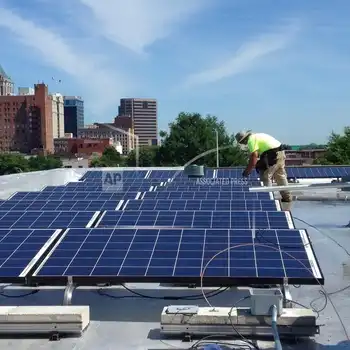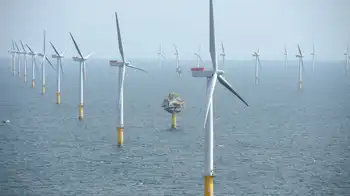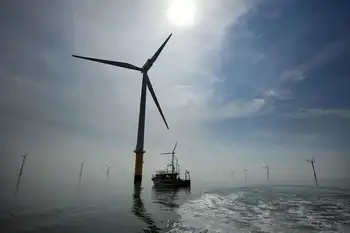Wind and solar power generated more electricity in the EU last year than gas. Here's how

Protective Relay Training - Basic
Our customized live online or in‑person group training can be delivered to your staff at your location.

- Live Online
- 12 hours Instructor-led
- Group Training Available
EU Renewable Energy Transition accelerates as solar and wind overtake gas, cutting coal reliance and boosting REPowerEU goals; falling electricity demand, hydro and nuclear recovery, and grid upgrades drive a cleaner, secure power mix.
Key Points
It is the EU's shift to solar and wind, surpassing gas and curbing coal to meet REPowerEU targets.
✅ Solar and wind supplied 22% of EU electricity in 2022.
✅ Gas fell behind; coal stayed near 16% with no major rebound.
✅ Demand fell; hydro and nuclear expected to recover in 2023.
European countries were forced to accelerate their renewable energy capacity after Russia's invasion of Ukraine sparked a global energy crisis amid a surge in global power demand that exceeded pre-pandemic levels. The EU’s REPowerEU plan aims to increase the share of renewables in final energy consumption overall to 45 percent by the end of the decade.
However, a new report by energy think tank Ember shows that the EU’s green energy transition is already making a significant difference. Solar and wind power generated more than a fifth (22 percent) of its electricity in 2022, pulling ahead of fossil gas (20 percent) for the first time, according to the European Electricity Review 2023.
Europe also managed to avoid resorting to emissions-intensive coal power for electricity generation as a consequence of the energy crisis, even as renewables to eclipse coal globally by mid-decade. Coal generated just 16 percent of the EU’s electricity last year, an increase of just 1.5 percentage points.
“Europe has avoided the worst of the energy crisis,” says Ember’s Head of Data Insights, Dave Jones. “The shocks of 2022 only caused a minor ripple in coal power and a huge wave of support for renewables. Any fears of a coal rebound are now dead.”
Ember’s analysis reveals that the EU faced a "triple crisis" in the electricity sector in 2022, as stunted hydro and nuclear output compounded the shock. "Just as Europe scrambled to cut ties with its biggest supplier of fossil gas, it faced the lowest levels of hydro and nuclear (power) in at least two decades, which created a deficit equal to 7 percent of Europe’s total electricity demand in 2022," the report says. A severe drought across Europe, French nuclear outages as well as the closure of German nuclear outlets were responsible for the drop.
Solar power shines through
However, the record surge in solar and wind power generation helped compensate for the nuclear and hydropower deficit. Solar power rose the fastest, growing by a record 24 percent last year which almost doubled its previous record, with wind growing by 8.6 percent.
Forty-one gigawatts of solar power capacity was added in 2022, almost 50 percent more than the year before. Ember says that 20 EU countries achieved solar records in 2022, with Germany, Spain, Poland, the Netherlands and France adding the most solar capacity.
The Netherlands and Greece generated more power from solar than coal for the first time. Greece is also predicted to reach its 2030 solar capacity target by the end of this year.
EU electricity demand falls
A significant drop in electricity use in 2022 also helped lessen the impact of Europe’s energy crisis. Demand fell by 7.9 percent in the last quarter of the year, despite the continent heading into winter. This was close to the 9.6 percent fall experienced when Europe was in Covid-19 lockdown in mid-2020.
"Mild weather was a deciding factor, but affordability pressures likely played a role, alongside energy efficiency improvements and citizens acting in solidarity to cut energy demand in a time of crisis," the report says.
A ‘coal comeback’ fails to materialize
The almost 8 percent fall in electricity demand in the last three months of 2022 was the main factor in the 9 percent fall in gas and coal generation during that time. However, Ember says that had France’s nuclear plants been operating at the same capacity as 2021, the EU’s fossil fuel generation would have fallen twice as fast in the last quarter of 2022.
The report says: "Coal power in the EU fell in all four of the final months of 2022, down 6 percent year-on-year. The 26 coal units placed on emergency standby for winter ran at an average of just 18 percent capacity. Despite importing 22 million tonnes of extra coal throughout 2022, the EU only used a third of it."
Gas generation was very similar compared to 2021, up just 0.8 percent. It made up 20 percent of the EU electricity mix in 2022, up from 19 percent the year before.
Fossil fuel generation set to fall in 2023
Ember says low-emissions sources like solar and wind power will continue to accelerate in 2023 and hydropower and French nuclear capacity will also recover. With electricity demand likely to continue to fall, it estimates that fossil fuel-generation "could plummet" by 20 percent in 2023.
Gas generation will fall the fastest, Ember predicts, as it will remain more expensive than coal over the next few years. "The large fall in gas generation means the power sector is likely to be the fastest falling segment of gas demand during 2023, helping to bring calm to European gas markets as Europe adjusts to life without Russian gas."
In order to stick to the 2015 Paris Agreement target of limiting global warming to no more than 1.5 degrees Celsius compared to pre-industrial levels, Ember says Europe must fully decarbonize its power system by the mid-2030s. Its modeling shows that this is possible without compromising the security of supply.
However, the report says "making this vision a reality will require investment above and beyond existing plans, as well as immediate action to address barriers to the expansion of clean energy infrastructure. Such a mobilization would boost the European economy, cement the EU’s position as a climate leader and send a vital international message that these challenges can be overcome."















